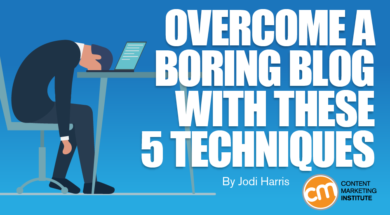
“A blog? Oh, that’s so 2010.”
You’ve heard that blogging is past its prime, takes too much effort, and lacks the power to connect with today’s distracted, time-crunched, and tech-savvy consumers.
Sure, social media trends, interactive tools and activities, and storytelling techniques like video, voice, and (to a lesser extent) virtual reality have shifted content preferences and habits.
Yet, blogging is still one of the top content types marketers use to build brand awareness and to nurture engaged audiences toward conversion.
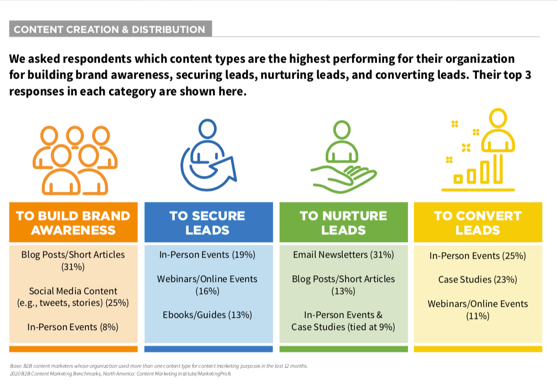
And because its versatility and creative flexibility can be as unlimited as your imagination, there’s a lot you can do to transform your blog from an average promotional vehicle to a desirable storytelling experience.
#Blogging is still a great way to attract a trusting, engaged audience, says @joderama via @CMIContent. Click To TweetConsider the following tips and techniques used by companies to stand out in their fields, fuel consumer passion, and showcase their values, insights, and expertise in distinct ways.
HANDPICKED RELATED CONTENT:
1. Highlight your community members and their creative talents
Great blogs deliver value to their readers. Often, it’s practical or instructional – like tactical advice, product or process tips, or use examples. But it can be more personally relevant and aspirational, such as giving audience members an opportunity to see and be themselves in the posts.
Thousands of makers rely on Etsy’s commerce-driven platform to promote their wares. This makes for a crowded space where even the most skilled artisans can struggle to distinguish their products. Because greater merchant success means greater success for Etsy, the company’s blog, Etsy Journal, helps site visitors discover new and top-selling shops by featuring master crafters in interviews, behind-the-scenes stories, and collection profiles.
.@Etsy lets its new and top-selling makers stand out by featuring them on its blog, says @joderama via @CMIContent. #Examples #ContentMarketing Click To Tweet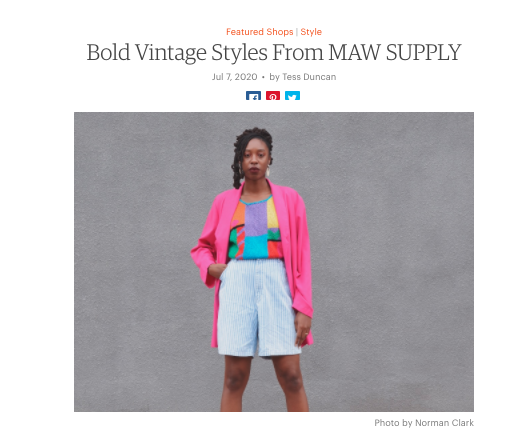
Photo by Norman Clark via Etsy
Another way to highlight your community is to invite members to contribute content ideas, creative expressions, and artistic talents to your blog content.
On The Drop blog, professional nail care brand OPI issues regular color and design challenges to its community of industry artists, influencers, and fans. Each week, the brand asks followers to create a manicure look using a specific color or design theme and post their artistry on Instagram with the tag #ColorIsTheAnswer. The OPI team highlights the favorite entries on the blog with step-by-step instructions on how to create the look.
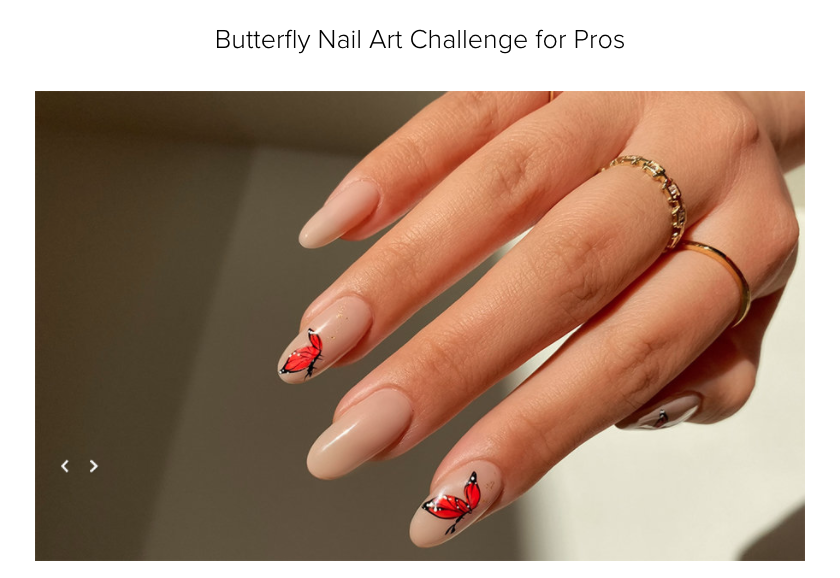
2. Explore your brand’s deeper purpose
It makes perfect sense that a brand like Starbucks would capitalize on its signature area of expertise for its Stories blog with posts on coffee roasting, new flavors and recipes, and ways to caffeinate any holiday experience. But the company’s blog content also serves a more stimulating purpose – to raise awareness of and amplify company efforts related to sustainability, inclusivity, and community well-being.
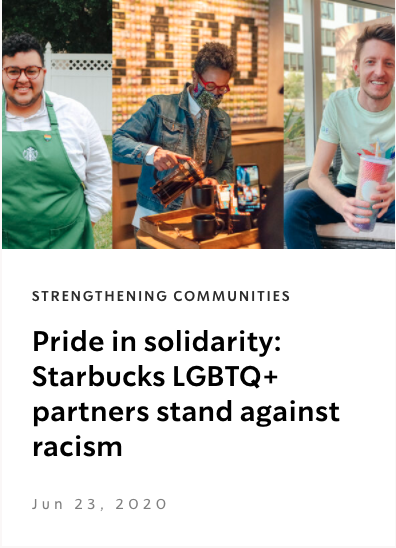
Communicating about your brand’s ideals, the values it upholds, and the causes it contributes to is a great way to elevate your blog content from a transaction-focused marketing vehicle to a truly meaningful conversation destination. But using your blog to demonstrate how your business is acting on those issues can garner even more attention.
Outdoor lifestyle brand REI excels in this arena. While you’ll certainly find gear reviews, how-to guides, and other adventurer-focused advice on the company’s Co-Op Journal blog, those stories often take a back seat to civic-minded priorities, like its recent roundtable discussion on racial injustice, its contributions to increasing inclusivity in the outdoor community, and its efforts to support environment-friendly legislation.
HANDPICKED RELATED CONTENT:
3. Cultivate an immersive, social-friendly experience
Another blogging trend is incorporating multiple media formats – image galleries, audio playlists, podcast episodes, and video collections. These techniques not only expand your brand’s storytelling platform and increase visitors’ time on-site, they can make your blog content more attractive to share on social media.
Using multiple media formats expands your #blog storytelling platform and increases time on-site, says @joderama via @CMIContent. Click To TweetWhen done well, these techniques can even simulate the experience your audience finds on their favorite social media sites. (If you can’t beat social media, you might as well steal ideas from it, right?)
Retailer Sole Bicycles leverages this technique beautifully through its aspirational and Instagram-friendly imagery of two-wheeled adventures, local art, and other relevant bike culture mainstays. In fact, I challenge you to tell the difference at a glance between the website image that leads to an image gallery-centric blog post and the one that takes viewers to its Instagram profile page:


Zoomin Software incorporates social-friendly elements into its blog with a different purpose in mind – easier navigation. The brand includes relevant tags and/or unique hashtags to segment its blog experience into distinct topical categories to let readers choose based on what they’re most interested in learning.
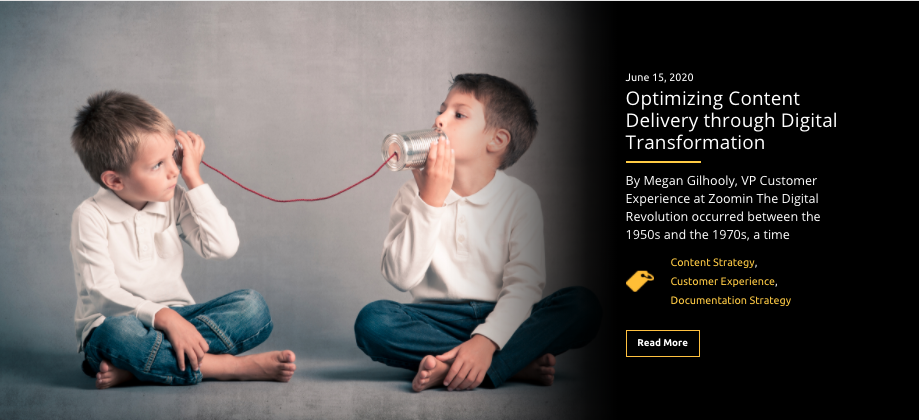
HANDPICKED RELATED CONTENT:
4. Go deep and hit home
Conventional wisdom dictates that blog content should be easy to read and understand – not to mention easy to write and publish quickly. Its supporting evidence includes popular blog trends like shorter posts, listicles, link blogs, and brief how-tos with lots of bullet points.
Conventional wisdom dictates that #blog content should be easy to read and understand and easy to write and publish quickly, says @joderama via @CMIContent. Click To TweetThese can be effective tactics, especially for attracting interest through search. But Orbit Media Studios’ latest blogging research shows that lengthier, more in-depth, and more immersive stories may be more effective even if it takes longer to create the content. Of the surveyed bloggers who reported strong results, 38% spend an average of six hours or more on a post, and 55% create posts that are 2,000 words or longer.
What returns can you expect from going the extra mile to write long-form blog content? Consider how Tim Urban built a recognizable content brand out of his passion for diving deeply into complicated issues and ideas.
Wait But Why is a master class on how to use thoughtfully conceived, highly detailed, and exhaustively researched long-form blog content to increase your profile as an influencer.
Despite the length of its posts (one recent entry weighed in at over 17,000 words!), WBW’s content experience is accessible to all kinds of audiences. This is due in part to signature features like Tim’s stick-figure-like graphics and the simple-but-not-really data visualizations he uses to break down tricky concepts into understandable ideas.

The episodic nature of his more immersive stories (like his analytical exploration of human nature) drives passionate readers back to his site again and again – even though it might be weeks or months between new posts.
All that extra effort has helped him generate revenue from his burgeoning content brand: The audience supports WBW in multiple ways, including joining its fee-based Patreon community, and buying merchandise at exclusive fan meet-up events like Wait But Hi.
HANDPICKED RELATED CONTENT:
5. Use visuals to add to or help tell your stories
While WBW uses rudimentary graphics as a defining feature of its content experience, there’s something to be said for letting elegant imagery elevate your brand’s blog conversations.
Augmenting written content with eye-catching visuals – in the form of memes, photos, stylized graphics, or data visualizations – can turn an everyday blog post into a rich, multifaceted story. In some cases, strategically crafted and curated images can do a better job than copy-laden storytelling.
Airstream’s blog excels at this visual-centric approach. Each post on the recreational vehicle brand’s blog page is highlighted by an emotionally relatable image that could tell a story on its own. For example, this cover image from a recent blog story on Airstream’s long-term involvement in the U.S. space program captures the brand’s history, quality standards, and lifestyle aspirations its customers seek from their RV voyages.
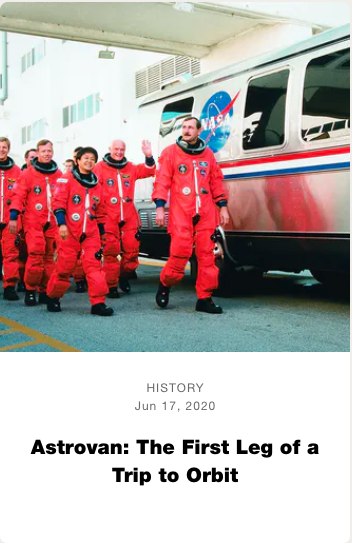
HANDPICKED RELATED CONTENT:
Beat your blogging blues
Though it may not offer the same street cred or conversational flair of trendy, tech-driven content formats, blogging remains a powerful way to engage your audience in meaningful, inspiring, and enduring conversations. If your blog is no longer performing to your brand’s expectations, why not give one – or a few – of these approaches a try?
Cover image by Joseph Kalinowski/Content Marketing Institute

